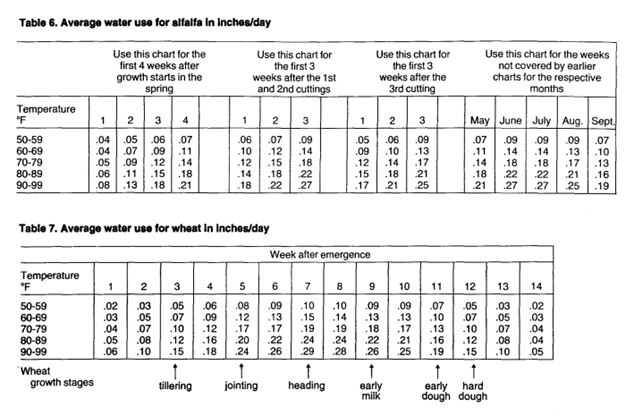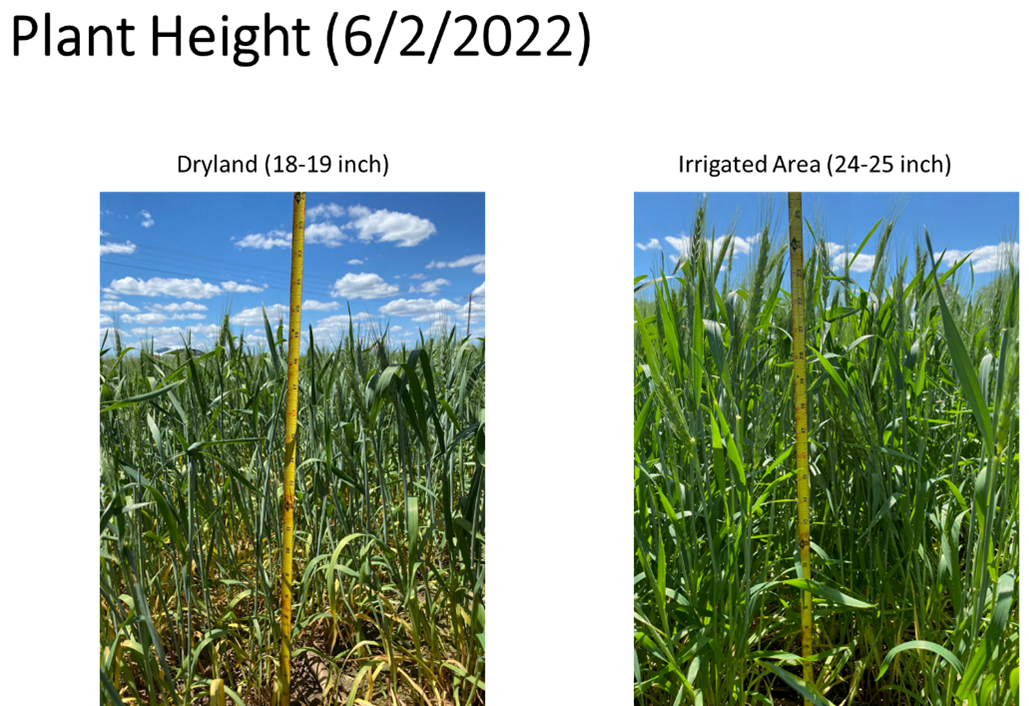Early season irrigation for small grains and forages
Irrigated small grains and alfalfa hay tend to have higher water demands when compared to most field crops and are often overlooked when it comes to timely irrigation.

Irrigated small grains for forage or grain, as well as alfalfa hay, play a key role in many dairy and vegetable operations. These early-season crops provide valuable rotation opportunities for vegetable growers and serve as an important source of spring forage for dairy producers. Small grains and forages are among the first crops of the season that can benefit from irrigation. Providing adequate water to meet the crop water needs allows you to maximize yield and quality while also maintaining adequate soil moisture to start the second crop. While May and June rainfall is often enough to support moderate yields, dry spells can reduce productivity and leave the soil moisture depleted for the next crop.
To achieve high yields in both forages and small grains, strategic irrigation is essential, especially when rainfall does not meet the crop water demand. Careful planning must take place early in the season to determine how much irrigation water to add and at what times to reduce the incidence of disease, produce high yields and create an environment conducive for the second crop to be established.
Irrigation scheduling is the process of deciding how much and when to apply water. The core principle is to replace the water used by the crop through evapotranspiration (ET), which is the combination of water lost from the soil surface and plant transpiration. For more information, refer to “What is evapotranspiration and why is it important in irrigation?” from Michigan State University Extension.
During the grain-fill stage, wheat can use up to 0.19 inches of water per day at an average temperature of 75 degrees Fahrenheit (or 0.25 inches per day at 85 F). This means that a 1-inch rainfall or irrigation event may only meet the crop's needs for about five days during this critical period. Maintaining adequate moisture during grain-fill is crucial for maximizing yield potential in both wheat and forage crops.
The following chart shows how wheat ET increases, peaks and declines as the crop matures and how crop water use increases as average daily temperatures increase. For irrigation scheduling purposes, the spring green-up of winter wheat and rye is equivalent to emergence. The two charts estimate daily water removal by wheat and alfalfa. These charts may also be used as a reference for forage crops in all small grains by looking for the equivalent stage of growth provided in the chart.
Although not as accurate as using reference ET and the crop coefficient method as described later, these charts offer a practical and good starting point for many producers. Some producers even keep a printed copy on their pickup dashboard for quick access.

A more accurate method to schedule irrigation involves using reference ET values available from your nearest Michigan State University Enviroweather station. To use, visit the Enviroweather website, select Potential Evapotranspiration Daily Summary and select your nearest station and date. The reference ET value is the amount of water that is estimated to be used at your location by a reference 6-inch grass. The crop coefficient, often referred to as Kc, is used as a multiplier to make up the difference between 6-inch grass and the crop you are growing.
Crop coefficient (Kc) for wheat. Table adapted from G1994 NebGuide, “Evapotranspiration Basics and Estimating Actual Crop Evapotranspiration from Reference Evapotranspiration and Crop-Specific Coefficients”
|
Wheat Growth Stage |
Crop Coefficient (Kc) |
|
Emergence |
0.10 |
|
Visible Crown |
0.50 |
|
Leaf Elongation |
0.90 |
|
Jointing |
1.03 |
|
Boot / Heading / Flowering / Grain Fill |
1.10 |
|
Soft Dough |
1.00 |
|
Ripening |
0.50 |
|
Full Maturity |
0.10 |
From the time the flag leaf has fully emerged through grain fill, wheat has a Kc of 1.10. This means wheat irrigation will need to be 110% of our reference ET. Spring rainfall varies between years, with 1 inch per week being the average for the Michiana area for late May and early June.
Typical water needs by small grains and forage during the same period range from 1.4 to 1.7 inches per week, depending on temperature and crop growth stage. In an average year, forages and small grains will use 2 to 2.5 inches of irrigation beyond rainfall. Without the addition of rainfall or irrigation and a deeply depleted soil moisture reserve, winter wheat and rye fields will start to show reduced growth and lower potential yield.

Ideally, small grain producers will develop an irrigation plan that will provide adequate soil moisture but minimize water applications two weeks prior to and two weeks after flowering. Less frequent, larger applications (1 to 1.25 inches) provide more water to the plant and fewer wetting events to elevate disease potential. This may be especially important if your irrigation system has the tendency to overapply water to portions of the field, as may be the case with some cornering arm systems. These areas are usually confined to small arcs in the field but can provide valuable locations to scout for the detection of wheat disease problems.
Additionally, Michigan State University (MSU) Extension provides weekly crop water use estimates for three regions across Michigan based on reference ET and crop coefficients according to each growth stage. You can find this information by accessing Crop Water Use.
For more information on irrigated small grain production, see the MSU Extension article, “Consideration for irrigating wheat.”
For more information about irrigated alfalfa production, see the University of Nebraska-Lincoln Extension article, “Irrigation Management and Crop Characteristics of Alfalfa.”
There are several paper and computer systems available to help irrigators schedule irrigation applications. These tools are “checkbook type systems” that view the water in the soil root zone as your checking account. Rainfall or irrigation serve as deposits in your account, and evapotranspiration is considered a withdrawal.
In addition, irrigation scheduling using a soil moisture sensor technology can be found in MSU Extension Bulletin E3445, “Improving Irrigation Water Use Efficiency: Using Soil Moisture Sensors.” Overviews of irrigation scheduling tools for Michigan are available at the MSU Extension Irrigation website and MSU Biosystems and Agricultural Engineering Irrigation website.



 Print
Print Email
Email